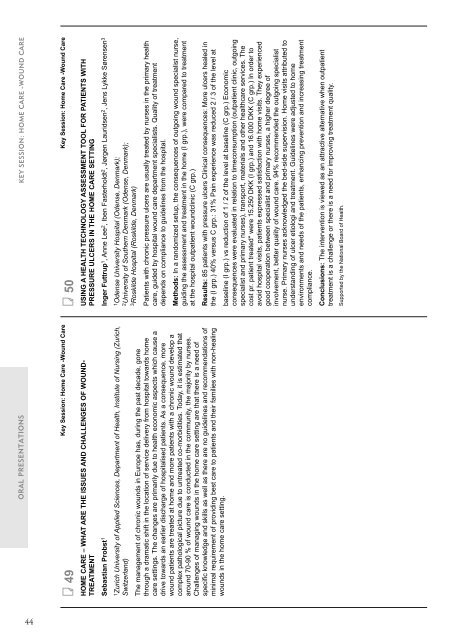You also want an ePaper? Increase the reach of your titles
YUMPU automatically turns print PDFs into web optimized ePapers that Google loves.
ORAL PRESENTATIONS<br />
49<br />
Key Session: Home Care -Wound Care<br />
Home Care – What are the issues and challenges of woundtreatment<br />
Sebastian Probst 1<br />
1 Zurich University of Applied Sciences, Department of Health, Institute of Nursing (Zurich,<br />
Switzerland)<br />
The management of chronic wounds in Europe has, during the past decade, gone<br />
through a dramatic shift in the location of service delivery from hospital towards home<br />
care settings. The changes are primarily due to health economic aspects which cause a<br />
drive towards an earlier discharge of hospitalised patients. As a consequence, more<br />
wound patients are treated at home and more patients with a chronic wound develop a<br />
complex pathological picture due to untreated co-morbidities. Today, it is estimated that<br />
around 70-90 % of wound care is conducted in the community, the majority by nurses.<br />
Challenges of managing wounds in the home care setting are that there is a need of<br />
specific knowledge and skills as well as there are no guidelines and recommendations of<br />
minimal requirement of providing best care to patients and their families with non-healing<br />
wounds in the home care setting.<br />
KEY SESSION: HOME CARE -WOUND CARE<br />
50<br />
Key Session: Home Care -Wound Care<br />
Using a Health Technology Assessment tool for patients with<br />
pressure ulcers in the home care setting<br />
Inger Futtrup 1 , Anne Lee 2 , Iben Fasterholdt 2 , Jørgen Lauridsen 2 , Jens Lykke Sørensen 3<br />
1 Odense University Hospital (Odense, Denmark);<br />
2 University of Southern Denmark (Odense, Denmark);<br />
3 Roskilde Hospital (Roskilde, Denmark)<br />
Patients with chronic pressure ulcers are usually treated by nurses in the primary health<br />
care, guided by hospital wound care department specialists. Quality of treatment<br />
depends on compliance to guidelines from the hospital.<br />
Methods: In a randomized setup, the consequences of outgoing wound specialist nurse,<br />
guiding the assessment and treatment in the home (I grp.), were compared to treatment<br />
at the hospital outpatient woundclinic (C grp.)<br />
Results: 85 patients with pressure ulcers Clinical consequences: More ulcers healed in<br />
the (I grp.) 40% versus C grp.: 31% Pain experience was reduced 2 / 3 of the level at<br />
baseline (I grp.) vs reduction of 1 / 2 of the level at baseline (C grp.) Economic<br />
consequences were evaluated in relation to timeconsumption (outpatient clinic, outgoing<br />
specialist and primary nurses), transport, materials and other healthcare services. The<br />
cost pr. patient treated* were 15.250 DKK (I grp.) and 16.000 DKK (C grp.) In order to<br />
avoid hospital visits, patients expressed satisfaction with home visits. They experienced<br />
good cooperation between specialist and primary nurses, a higher degree of<br />
involvement, better quality of wound care. 94% recommended the outgoing specialist<br />
nurse. Primary nurses acknowledged the bed-side supervision. Home visits attributed to<br />
understanding of ulcer etiologi and treatment. Guidelines were adjusted to home<br />
environments and needs of the patients, enhancing prevention and increasing treatment<br />
compliance.<br />
Conclusions: The intervention is viewed as an attractive alternative when outpatient<br />
treatment is a challenge or there is a need for improving treatment quality.<br />
Supported by the National Board of Health.<br />
44






